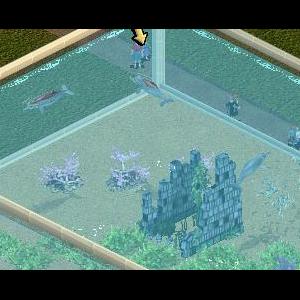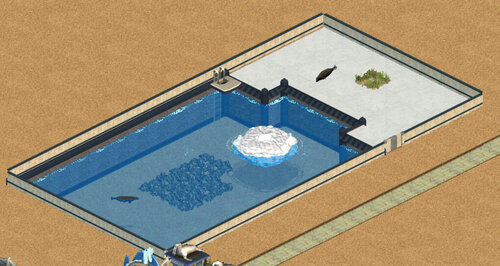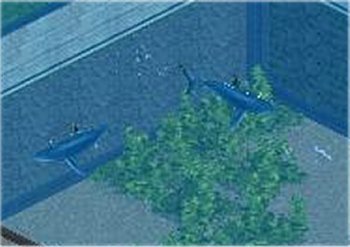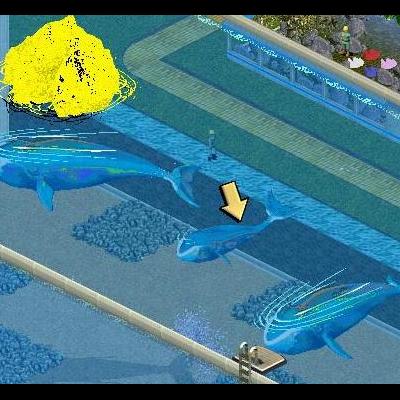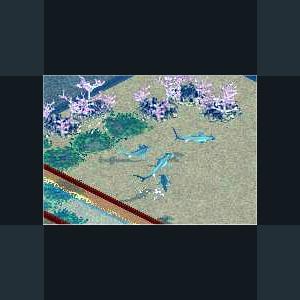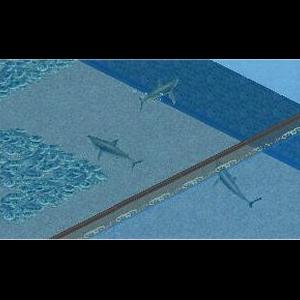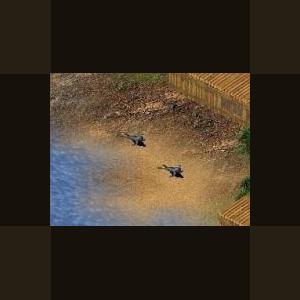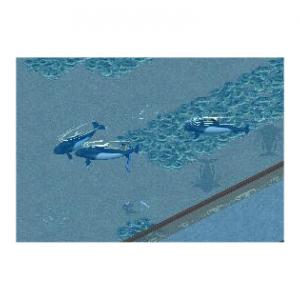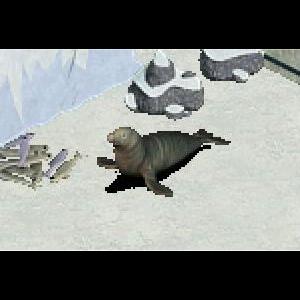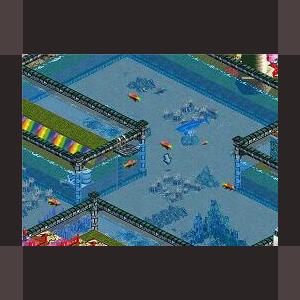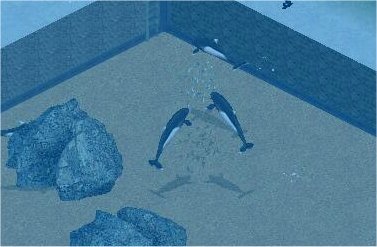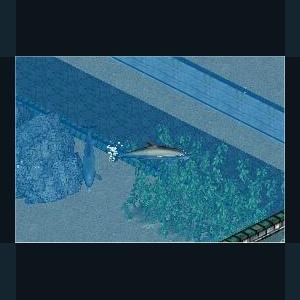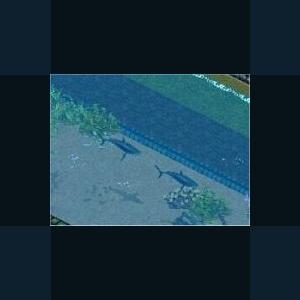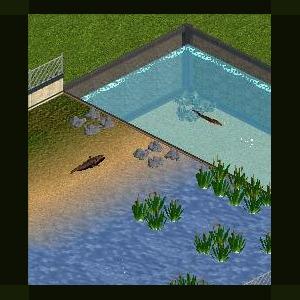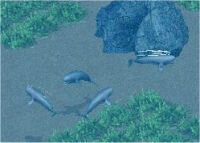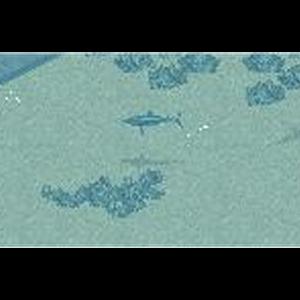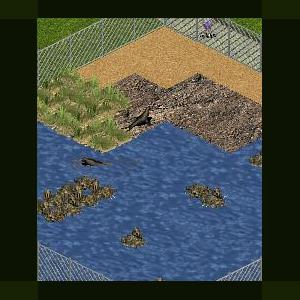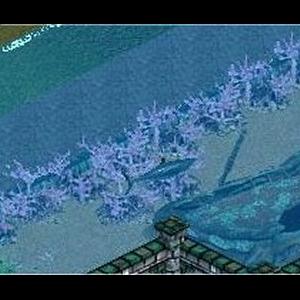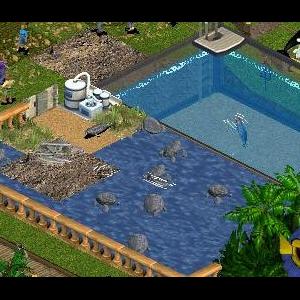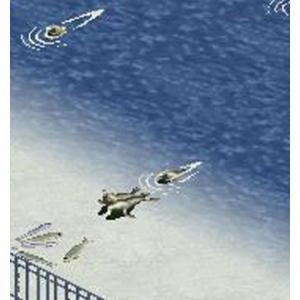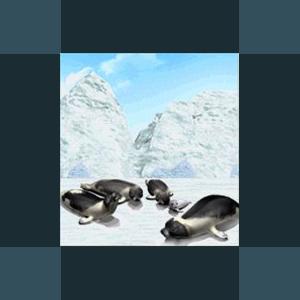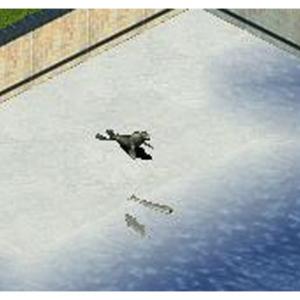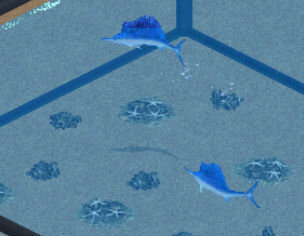Marine
Creatures under the sea
47 files
-
Baiji by Tasmanian_tiger
By Tasmanian_tiger
The baiji is a freshwater dolphin found only in the Yangtze River in China. The dolphin is also called Chinese River Dolphin, Yangtze River Dolphin, Whitefin Dolphin and Yangtze Dolphin. The Baiji population declined drastically in decades as China industrialized and made heavy use of the river for fishing, transportation, and hydroelectricity. Efforts were made to conserve the species, but a late 2006 expedition failed to find any Baiji in the river. Organizers declared the Baiji "functionally extinct",[4] which would make it the first aquatic mammal species to become extinct since the demise of the Japanese Sea Lion and the Caribbean Monk Seal in the 1950s.
I hope you enjoy this addition to your zoos. Combine the baiji with pandas to create lively 'river-tanks'.
Updated: July 10, 2013 by Jay to correct 3 animation views, to remove unnecessary files and configuration lines, and to make some minor adjustments to the animal info.
The update dated Jul 28 2013 is not an update. It is because I moved the file from Animals to Marine.
919 downloads
Updated
-
Bearded Seal by Khaydar
By Khaydar
Adopt a Bearded Seal (Erignathus barbatus) for your zoos.
Bearded Seal description:
Minimum happiness needed for chance of breeding: 90.
Liked foliage:
Horsetail (DD), Arctic Birch Tree (DD), Arctic Grass (DD), Arctic Bush (DD)
Beach Grass (MM)
Liked rock:
Small Ocean Floor Rock (MM), Large Ocean Floor Rock (MM)
Medium Coral Formation (MM), Iceberg (MM), Isle Rock (MM), Large Rock
Small Rock - Medium, Small Rock - Small, Large Snowy Rock - Medium
Large Snowy Rock - Large, Small Snowy Rock - Medium, Small Snowy Rock - Small
Number of animals allowed per exhibit:
1-4 with 60 squares each.
A suitable exhibit for 2 of this animal has 120 squares containing terrain of:
84 Salt Water, 36 Snow
using 2 grid squares filled with 4 Arctic Grass (DD) most liked plant
and using 29 Small Ocean Floor Rock (MM) most liked rock.
Other liked items:
Tank Filter (MM), Snowy Rock, Ice Floe (MM)
Credits to Jannick for the model and mesh
Made by Khaydar
210 downloads
- marine animal
- seal
- (and 2 more)
0 comments
Updated
-
Blue Shark by Ghirin
By Fern
Author: Ghirin
Description : The blue shark (Prionace glauca) is perhaps the most widely distributed pelagic species of shark. This shark is found in all of the world's oceans and has a preference for cooler waters (7-16 degrees C). It is often seen swimming near the surface but will dive to depths over 100 meters. Blue sharks have wide migratory patterns. Individual blue sharks have been tracked between different sides of oceans. Their diet is composed mainly of small schooling fishes such as anchovies and herring. Other foods such as squid and wounded marine mammals will be consumed if available.
As its name suggests, the blue shark has a deep blue upper body and a white ventral surface. The body is slender and the pectoral fins are long.
Male and female blue sharks live separately, coming together only for mating. Females are viviparous and very prolific. Litters can range in size from 15 to 130 pups.
*Inspired by the ZooTycoons Brains Trust at the Zoo Tek Forums.
164 downloads
0 comments
Submitted
-
Blue Whale by JohnT
By Admin Uploader
Thank you for downloading the Blue Whale. Blue Whales are the largest known whale in the world. Blue Whales like a variety of foliage in their exhibits.
Thank you to Fern, Jay and Dr. Rick for their invaluable encouragement, guidance and expertise; and to Caddie and Pukkie for their testing expertise.
296 downloads
0 comments
Updated
-
Bonnethead Shark by Ghirin
By Guest
The bonnethead shark (Sphyrna tiburo) is one of the the smallest members of the hammerhead shark family. These small sharks prefer tropical and subtropical coastal regions where there is continental shelf and are exclusive to the western hemisphere. Bonnethead sharks migrate to warmer waters during the winter months.
Bonnethead sharks are easy to distinguish from other hammerheads by the shape of their heads, which is more shovel-shaped than other hammerhead species. Their diet consists of crustaceans such as blue crabs and shrimp, mollusks, and small fishes. Females tend to consume more food, possibly to provide energy for reproduction.
This species of shark usually forms schools of up to fifteen individuals and they use their cerebrospinal fluid for communication between individuals. During birthing season (these sharks are livebearers), females predominate in shallow waters.
*Inspired by the Zoo Tycoon Brains Trust at the Zoo Tek Forums.
References:
-Hessing, S. 2000. "Sphyrna tiburo" (On-line), Animal Diversity Web. http://animaldiversi...rna_tiburo.html.
-Bester, C. "Bonnethead" (On-line), Florida Museum of Natural History.
http://www.flmnh.ufl...Bonnethead.html
Created by Ghirin 2004
732 downloads
Updated
-
Bronze Whale by Ghirin
By Guest
The bronze whaler (Carcharhinus brachyurus) is found in open seas as well as coastal areas and reefs. It is thought to feed on fish, small sharks and cephalopods.
Female bronze whalers give birth to 13-20 live young which can then live independently.
*Inspired by the Zoo Tycoon Brains Trust at the Zoo Tek Forums.
Reference:
Sharks, Ferrari and Ferrari. 2002.
Ghirin 2005
416 downloads
0 comments
Updated
-
Caspian Seal by Ghirin
By Guest
The Caspian seal (Pusa caspica) is one of the smallest true seals in the world. It is native to the brackish waters of the Caspian Sea.
The Caspian seal is thought to be derived from the ringed seal of the Arctic and is close relative of the Siberian nerpa.
References:
http://en.wikipedia.org/wiki/Caspian_Seal
http://www.caspianenvironment.org/biodb/eng/mammals/Phoca%20(Pusa)%20caspica/main.htm
Created by Ghirin 2008
466 downloads
0 comments
Updated
-
Commersons Dolphin by Ghirin
By Guest
Commerson’s dolphin (Cephalorhynchus commersonii), also known as the piebald dolphin, is native to coastal waters of the southwestern Atlantic Ocean. (A second population has been identified in the Indian Ocean.) This dolphin is easy to recognize due to its striking black and white skin pattern. Young are born grey and become two-toned with age.
Commerson’s dolphins prefer coastal waters where the continental shelf is wide and flat. Their diet consists of squid, crustaceans, and fish. They usually travel in small groups of two to four animals, but large schools have been reported.
*Inspired by the Zoo Tycoon Brains Trust at the Zoo Tek Forums.
References:
Walker’s Mammals of the World. Nowak, 1999.
Animal: The Definitive Visual Guide the World’s Wildlife. Burnie and Wilson, 2001.
http://www.bbc.co.uk/nature/wildfacts/factfiles/79.shtml
Created by Ghirin 2004
435 downloads
0 comments
Updated
-
Crabeater Seal by Ghirin
By Guest
Crabeater Seal by Ghirin
The crabeater seal (Lobodon carcinophagus) is one of the most common large mammals in Antartica.
It is known for its complicated tooth pattern which forms an interlocking sieve for filtering krill.
Crabeater seals usually haul out on the pack ice, but have also been known to travel inland.
*Inspired by Professor Paul's Nature Encyclopedia at the Zoo Tek Forums*
References:
http://en.wikipedia.org/wiki/Crabeater_Seal
http://www.antarcticconnection.com/antarct...crabeater.shtml
442 downloads
0 comments
Updated
-
Cuban Hog Fish by JT (JohnRN1)
By Cricket
Thank you for downloading the Cuban Hog Fish. This colorful saltwater fish was made for the 2012 Tek Anniversary. Congratulations Tek.
"Move the .ztd file into the dlupdate (and not dupdate) folder if one exists in your Zoo Tycoon folder; otherwise move the .ztd file into the Updates folder that is in the Zoo Tycoon folder."
The default is C:\Program Files\Microsoft Games\Zoo Tycoon
Thank you to Fern and Jay for their invaluable encouragement, guidance and expertise.
--JohnT--
374 downloads
0 comments
Updated
-
Dall's Porpoise by Ghirin
By Guest
Dall’s porpoise (Phocoenoides dalli), also known as the white-flanked porpoise, is a robust porpoise with a striking black and white piebald pattern. It is reported to be a fast cetacean (reaching speeds up to 55 km/hr for short periods) and regularly rides the bow waves of ships when the vessel is moving at a minimum of 26 km/hr. Dall’s porpoises are also known for sending up “rooster-tail” water sprays when they surface.
Dall’s porpoises are native to the northern Pacific Ocean and range from Japan to California. Unlike several other porpoise species, Dall’s porpoise is regularly reported in open oceanic waters. It often forms groups of two to twelve individuals, but these small schools have been known to merge into groups of several thousand.
Their diet consists mainly of squid, fish, and krill.
*Inspired by the Zoo Tycoon Brains Trust at the Zoo Tek Forums.
References:
Walker’s Mammals of the World. Nowak, 1999.
Animal: The Definitive Visual Guide the World’s Wildlife. Burnie and Wilson, 2001.
http://www.bbc.co.uk/nature/wildfacts/factfiles/128.shtml
Updated August 18, 2018 by Cricket so that screenshot would show up again.
Created by Ghirin 2004
391 downloads
0 comments
Updated
-
Delphin by Ghirin
By Guest
Delphin by Ghirin
Delphin (called Delphinus by the Romans) was the dolphin companion of the Greek god Poseidon. Today, Delphin is found among the stars as the constellation Delphinus.
278 downloads
0 comments
Updated
-
Dusky Shark by Ghirin
By Guest
Dusky Shark Author: Ghirin
The dusky shark (Carcharhinus obscurus) has a wide distribution among the coastlines of temperate and tropical regions, with major populations found in the western Atlantic Ocean, western Indian Ocean, Mediterranean Sea, Pacific coast, and Australian waters. This shark prefers the relatively shallow waters of continental shelves. Young dusky sharks may congregate in bays and estuaries; however, adult dusky sharks avoid areas of low salinity. Dusky sharks are highly migratory. The exact path of migration varies with specific shark populations and is seasonal in nature.
Dusky sharks prey on bottom-dwelling fish and invertebrates (i.e., skates, crabs, flatfish). They will also feed on pelagic fishes. Dusky sharks are viviparous with litter sizes ranging from 3 to 14 pups.
*Inspired by the Zoo Tycoon Brains Trust at the Zoo Tek Forums.
Created by Ghirin 2004
394 downloads
0 comments
Updated
-
0 comments
Submitted
-
Finless Porpoise by Ghirin
By Guest
Finless Porpoise Author: Ghirin
The finless porpoise (Neophocaena phocaenoides) is found in the costal waters from the Persian Gulf to Japan. Populations are also found in adjacent estuaries, rivers, and shallow channels. They prefer shallow waters (up to 50 m deep) with soft or sandy bottoms.
Due to its lack of a dorsal fine, it is easy to identify in the wild. The living animal is often blue-gray and may darken after death. The neck vertebrae are not fused, allowing the animal to turn its head. Males may grow to 2 m and females range up to 1.5 m in length.
Finless porpoises often seen in singly or in groups of 2-4. Large groupings of up to 20 have been reported. Their primary diet consists of small fish, squid, crustaceans, and octopus.
Created by Ghirin 2003
433 downloads
0 comments
Updated
-
Fresh Water Bull Shark by Ghirin
By Guest
The bull shark (Carcharhinus leucas) is a large, robust shark found in shallow coastal marine waters worldwide. These sharks will also enter and live in estuaries, freshwater lakes and rivers.
Bull sharks eat both bony fishes and small sharks. In the cooler portions of their range, bull sharks mate during the summer months; however, in the warmer parts of their range they may breed year-round. Females nourish the young internally for 10 to 11 months and give birth to free-swimming pups.
*Inspired by the Zoo Tycoon Brains Trust at the Zoo Tek Forums.
Reference:
http://www.flmnh.ufl.edu/fish/Gallery/Descript/bullshark/bullshark.htm
Created by Ghirin 2004
501 downloads
0 comments
Updated
-
Galapogos Sea Lion by Jordan MK
By Guest
Genus: Zalophus
Species: californianus wollebaeki
Identification:
There are three subspecies of Zalophus californianus. The California sea lion (Z. c. californianus) is found from southern Mexico up to British Columbia and breeds almost entirely on islands in southern California, western Baja California and the Gulf of California. The Galápagos sea lion (Z. c. wollebaeki) is found on the Galápagos Islands and also occasionally in coastal Ecuador and Colombia. The Japanese sea lion (Z. c. japonicus) is now believed to be extinct but was formerly found in the Sea of Japan. Some scientists believe that these three subspecies should in fact be classed as separate species, namely Z. californianus, Z. wollebaeki, and Z. japonicus.
Population:
There is no up-to-date count of Galápagos sea lions, the last reported population estimate of 30,000 being made in the late 1970s.
Endangerment Status:
The Galápagos sea lion is listed as Vulnerable on the IUCN Red List. This subspecies was not subjected to the same commercial exploitation that caused the depletion of California sea lion populations, although occasional sea lions were killed for their skins or to provide tooth necklaces for tourists. Many Galápagos sea lions have been and are still being killed as a result of illegal and local fishing activities around the islands, despite the Ecuador government expanding the no-fishing zone around the islands from 15 to 40 nautical miles in early 1998. The entanglement of sea lions in fishing gear, particularly in long-line hooks and nylon line, is one of the most important problems currently affecting the subspecies. Entanglement in marine debris is an additional problem. Between 1995 and November 2000 a total of 111 reports of entangled sea lions were received.
El Nino:
Galápagos sea lions are badly affected by the lack of food availability and weather conditions produced by El Niño events. During the 1982-83 El Niño all Galápagos sea lion pups born in 1982 died, while only a third of the normal number of pups were born in 1983. During the 1997-98 El Niño, the Galápagos sea lion population showed a significant decline in almost all of its colonies, a 48% population decrease caused by both mortality and migration having been observed during this period. The most affected age range were pups born between June 1997 and December 1998, suffering a 90% mortality rate. The large male sea lions, especially the dominant sea lions during the 1998 breeding season, experienced a 67% mortality rate. During the El Niño event it was found that the sea lions tried to make up for the lack in prey by feeding on lantern fish (Myctophidae) rather than the usual sardines (Clupeidae), and exhibited behavioural changes such as foraging during the night. The mortality rates indicate however that this modification in foraging behaviour was not enough to protect the population from the effects of the event. A recovery in the Galápagos sea lion population has been observed during 1999 and 2000, with an estimated 10% increase in the population. Pups born during the 1999-2000 breeding season were observed to be in good condition.
Reproduction:
Pups are born and breeding takes place on the sandy and rocky beaches of the Galápagos Islands from May - January, the timing varying from island to island. About 4-7 days after her pup is born, the mother leaves to feed at sea, thus beginning a cycle of feeding during the day, mainly at depths of 20-60m, and returning most nights to feed her pup. The pup can be nursed for as little as 6 months, but is often nursed for a year until the next pup is born. Some mothers have been known to nurse both their new pup and old pup for periods of up to a year. It is also occasionally known for mothers to nurse a single pup for up to 3 years, as long as they do not give birth to a new pup during this period. Galápagos sea lions do not migrate, remaining around the islands all year and feeding at shallow depths, mainly for sardines.
Created by JordanMK
349 downloads
Updated
-
Galapogos Shark by Ghirin
By Guest
The Galapagos shark (Carcharhinus galapagensis) is a common resident in the coastal waters of many tropical islands. This shark prefers shallow waters but has been known to swim in the deep water between islands. They are usually found near coral reefs.
Galapagos sharks feed on bottom-dwelling fishes such as flatfish and triggerfish. It is a viviparous species with litter sizes ranging from 6 to 16 pups. The young sharks form “nurseries” in shallow water to avoid predation by larger sharks.
This shark is known for its display when it feels threatened. The back is arched, the head is raised, and the pectoral and tail fins are lowered. The shark then swims in a twisting, rolling motion.
*Inspired by the Zoo Tycoon Brains Trust at the Zoo Tek Forums.
References:
http://www.shark.ch/cgi-bin/Sharks/spec_conv.pl?E+Carcharhinus.galapagensis
http://www.flmnh.ufl.edu/fish/Gallery/Descript/GalapagosShark/Galapagosshark.html
Created by Ghirin 2004
409 downloads
0 comments
Updated
-
Habour (or Common) Seal by Tasmanian Tiger
By Fern
Harbour (or Common) Seal
Author : Taz (Tasmanian_tiger)
Category : Real animal, Pinniped
Updated: June 29, 2013 by Jay to correct 3 animation views, to remove unnecessary files and configuration lines, and to correct configuration mistakes done by the APE program, primarily related to animal behaviors and to sounds. Please note that the version at Taz's site is no longer the most current version, since she is deceased.
Current ztd date: June 29, 2013
Compatibility : All Game Versions
Description : The most widespread pinniped, the Common or Harbour Seal has a plump body and a small, cat-like head with a slight forehead and nostrils that form a V-shaped pattern. Its coat ranges from light to dark grey or brown, and has spots, rings and blotches all over. The breeding season varies regionally, and the pups are able to crawl and swim almost within an hour of birth. There are at least five subspecies of Common Seal. One of them, the Ungava Seal, lives in fresh water in N. Quebec, Canada. (Text by Dorling Kindersley Handbooks.)
530 downloads
0 comments
Updated
-
Harp Seal by Ghirin
By Guest
The harp seal (Phoco groenlandica) is native to the north Atlantic ocean, ranging from the Gulf of St. Lawrence to Greenland. The fur of the seals changes with the age of the seal. The coat of the pup is white, turning gray after a few weeks. The adult coat has a background color of silvery gray with dark markings on the head and a dark band running up each flank and over the back that resembles a horseshoe or a harp.
The harp seal spends most of its time in the open sea or on ice. In the spring, the harp seals haul out on the sea ice for moulting, birthing pups, and breeding. Large numbers of seals may come together during this time.
Harp seals feed on fish and crustacenas. They bite breathing holes into the ice so that they have access to fresh air between dives for food.
References:
http://www.pagophilus.org/harpseals.htm
http://www.bbc.co.uk/nature/wildfacts/factfiles/166.shtml
Walker's mammals of the World, Nowak, 1999
Photograph:
http://www.pagophilus.org/birth.htm
Created by Ghirin 2003
412 downloads
0 comments
Updated
-
Harp Seal by Tasmanian_tiger
By Fern
Author : Taz (Tasmanian_tiger)
Category : Real animal, Pinniped
Updated: September 25, 2013 by Jay to remove the background for the male and female animal list icons, to add an animal list icon for the young, to remove the top and bottom edges of the purchase menu icons, to adjust the positions of all animations, to make minor adjustments to the animal info, to add the preferred object tooltip for the female and young, to add the capability of a simple surface roll trick for show tanks, to add the capability to use 3 user made toys, to remove unnecessary files and configuration lines, and to correct configuration mistakes done by the APE program.
Current ztd date: September 25, 2013
Compatibility : All Game Versions
Description : The Harp Seal is somewhat larger than the Common Seal, growing to 5.5 ft (1.67 m) long and with a weight of 115-180 kg (253-400 lb). Males are distinctly larger than females. Harp Seals are well known for the saddle-like spot on their backs. Adult males are creamy white overall, with a dark chocolate brown head and a broad dark chocolate brown U-shaped pattern on their back, running across the shoulders and down each flank to near the base of the tail; the pattern is often slightly asymmetrical and irregular, with dark brown spots extending onto the white parts. Adult females have a similar but less distinct pattern, with the brown being paler and greyer. Immature Harp Seals up to two to three years old are pale grey, variably spotted with darker grey. The flippers are white or pale grey, with five stout claws on each fore flipper. The tail is short, 10-15 cm long. The fur on adults is 2 cm long, dense, stiff, and velvety; the skin is roughly the same color as the fur: whitish-grey under the white fur, and dark brown under the brown fur. The vibrissae are numerous on the muzzle, the longest about 12 cm long. The newborn pups are all white except for a black nose and eyes, which helps them blend in with the snow. Puberty is reached at 5-7 years, and the maximum lifespan is more than 30 years. Since newborn harp seals do not enter the water for a number of weeks, the young of this harp seal does not go in water. This Harp Seal can use the Ice Floe For Certain Animals By Taz, the Ice Floe For Certain Animals, and the Raft For Certain Animals. The Harp Seal is compatible with the Emperor Penguin, although the Emperor Penguin doesn't like it but will accept its presence and cause no problems. However, if the Emperor Penguin is in the same exhibit, then the exhibit must not have the Ice Floe For Certain Animals By Taz, the Ice Floe For Certain Animals, or the Raft For Certain Animals, since the penguin could get stuck on those toys, being that the penguin is not configured for those toys. The Harp Seal is also compatible with the Ribbon Seal made by Taz.
Note: ZT is not used to animals where the adults go in tanks while the young do not. So it can keep changing its mind between the exhibit being suitable and the exhibit needing more salt water terrain and less snow. Whenever it does change its mind and wants more salt water terrain, do so. Eventually it will get to a point where it does not change its mind.
569 downloads
0 comments
Submitted
-
Hawaiian Monk Seal by Ghirin
By Guest
Hawaiian monk seals (Monochus schauinslandi) are found in the outer islands of the Hawaiian chain. Their genus, Monachus, is the only seal genus found in the tropics.
441 downloads
0 comments
Updated
-
Hooded Seal by Ghirin
By Guest
The hooded seal (Cystophora cristata) occurs mainly in the northern Atlantic ocean from Newffoundland to Greenland. Individuals have been reported as far west as iceland and as far south as Florida. The hooded seal gets it name from the enlarged, inflatable nose of the male. To inflate the hood, the male closes his nostrils and fills his nose with air. The male can also blow a bright red ballon (made from the nasal septum) out of one nostril instead of inflating the hood. Females also have a hood, but it smaller and is not inflatable.
Hooded seals prefer to live in deep water areas where there is thick floating ice. During early spring, females haul out on the sea ice to give birth to their pups. This is also the mating season, when males display to the females, using their hoods as threats to rival males.
Hooded seals feed on fish, cephalopods, shrimp, and mussels.
References:
Walker's Mammals of the World, Nowak, 1999
http://www.bbc.co.uk/nature/wildfacts/factfiles/602.shtml
Photograph:
http://www.americazoo.com/goto/index/mammals/330.htm
Created by Ghirin 2003
316 downloads
0 comments
Updated
-
Indo-Pacific Sailfish by Khaydar
By Khaydar
Adopt an Indo-Pacific Sailfish (Istiophorus platypterus) for your zoos.
Animal guide
Cannot be used in original Zoo Tycoon: Needs Marine Mania.
Minimum happiness needed for chance of breeding: 96.
Liked foliage:
Sea Anemone (MM), Brittle Sea Star (MM), Orange Cup Coral (MM)
Divercate Tree Coral (MM), Feather Duster Worm (MM), Fire Coral (MM)
Sargassum (MM), Sand Dollar (MM), Sea Cucumber (MM), Sea Grass (MM)
Sea Sponge (MM), Stove Pipe Sponge (MM), Tube Worm (MM)
Purple Sea Urchin (MM)
Liked rock:
Small Ocean Floor Rock (MM), Medium Ocean Floor Rock (MM)
Large Ocean Floor Rock (MM), Medium Coral Formation (MM)
Large Coral Formation (MM), Isle Rock (MM)
Number of animals allowed per exhibit: 1-6 with 30 squares each.
A suitable exhibit for 2 of this animal has 60 squares containing terrain of:
60 Salt Water
using 4 Brittle Sea Star (MM) most liked plant
and using 43 Small Ocean Floor Rock (MM) most liked rock.
Other liked items:
Giant Pacific Clam (MM), Treasure Chest (MM), Deep Sea Diver Statue (MM)
359 downloads
- living animal
- khaydars animal
- (and 1 more)
Updated
-
Japanese Sea Lion by Coolperson5
By Guest
Japanese Sea Lion (Zalophus japonicus) is thought to have become extinct in the 1950s.
Prior to 2003 it was considered to be a subspecies of California Sea Lion as Zalophus californianus japonicus. However, it was subsequently reclassified as a separate species. Some taxonomists still consider it as a subspecies of the California Sea Lion. It has been argued that japonicus, californianus, and wollenbaeki are distinct species because of their distant habitation areas and behavioral differences.
They inhabited the Sea of Japan, especially around the coastal areas of the Japanese Archipelago and the Korean Peninsula. They generally bred on sandy beaches which were open and flat, but sometimes in rocky areas.
Currently, several stuffed specimens can be found in Japan and the National Museum of Natural History, Leiden, the Netherlands brought by Philipp Franz von Siebold. The British Museum possesses a pelt and 4 skull specimens.
444 downloads
0 comments
Updated

